Memphis Transition Drills
From the Coach’s Clipboard Basketball Playbook"Helping coaches coach better..."
The Memphis transition offense/defense drills were used by John Calipari when he was at Memphis years ago. Some of these drills are similar to some of our drills (4-on-4 transition, 4-on-4-on-4 transition, and Michigan State progressive transition drills).
Drills
- Blood-33 Drill
- Knick Drill
- Fresno-11 Drill
- Fresno-22 Drill
- Colors Drill
- Skip 2-vs-1 "Cardinal" Drill
- Progression Drill
Blood-33 Drill
See the diagrams below. This 3-on-3 drill has two teams, blue and white, with white on offense on one end (bottom) and blue on offense on the other end (top). This drill teaches the dribble-penetrator how to read and react to the defense. Guards start in the back-court (defender at half-court), and the shooters are in either corner, and post players start at the high post.Diagram A. The coach passes the ball to the offensive guard in the back-court. His/her defender is in the half-court circle and touches the dribbler IN THE CIRCLE and then tries to slow down and stop the ball. If this defender does not touch the dribbler in the circle, it's a point for the offense.
The dribbler attacks the seam on the side of the court where the shooter is located. The offensive post player sprints to the weak-side block while the post defender drops to the middle of the lane.
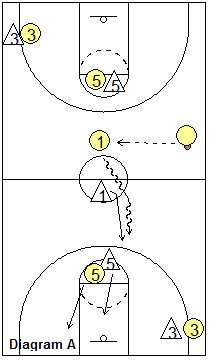
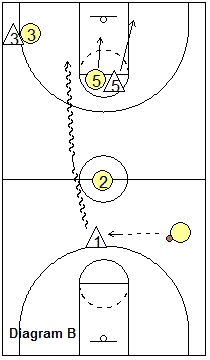
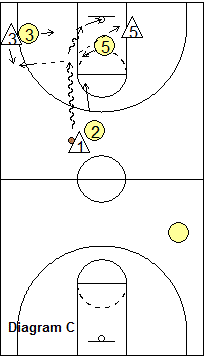
Diagram C shows what we are trying to accomplish on offense. O1 attacks the seam with the dribble and must read and react to the defense. The first read is the corner defender. If X3 drops inside to help, O3 should take a step up into a passing lane and O1 passes to O3 for the 3-point shot. The second read is the X5 defender. If X5 slides over to help, O1 should pass to O5. If neither X3 or X5 give help, O1 should take it strong to the hoop for the lay-up and either score or get fouled.
O3 in the corner also has to read the X3 defender. If the X3 defender drops inside to give help (diagram C), O3 takes a step up higher, so he/she has an open passing lane from O1. If the X3 defender is denying the pass to O3 (diagram B), O3 looks to back-cut to the hoop for the pass from O1. If the point guard is stopped and O3 is denied, O5 flashes high to get the pass.
Rotate offense to defense once there is either a score or a stop. O1 goes to the end of the line for his/her team. X1 now becomes the offensive point guard and the coach passes the ball to him/her to start things going the opposite direction. Notice in diagram B, a new guard comes in for the white team, X2. After each possession, the point defender changes, but the wings and posts stay.
Play to a certain number with losers running (or doing push-ups). Once the game number is reached, you can flip the wings and post-players (keep the wings and posts on the same end of the floor but switch offense and defense).
Knick Drill
This is a 4-on-4-on-4 drill with three 4-player teams. Each team keeps its own score. The drill is very similar to our 4-on-4-on-4 drill, except that the Knick drill uses three defenders with one running in from half-court and the 4-on-4-on-4 drill starts with two defenders and two sprinting in from half-court.See diagram A below. We start with four blue players bringing the ball into the forecourt against three yellow defenders. One defender is on the sideline at half-court, and once the ball crosses the half-court line, the defender sprints in, touches the circle, and then sprints back to defend.
Both teams play until there is either a score or a stop. If the yellow team gets a stop and rebounds, or gets a steal, they immediately fast-break up the court (without back-court defense from blue). The three red defenders are waiting to stop them, with one red defender sprinting in from half-court.
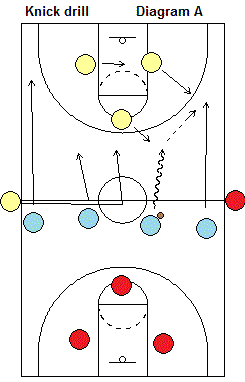
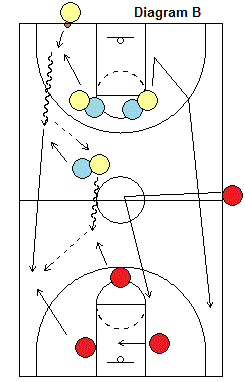
In diagram B, we shows what happens after a score. The yellow team inbounds the ball, while the blue team presses until the ball crosses half-court (blue does not go beyond half-court, as that is where the red defense takes over). If the pressing blue team steals the ball, they immediately attack and try to score.
One point for each basket. Play to a certain score with the two losing teams running (or doing push-ups). Another option is no press after the score, as the team that just scored goes off.
There is a variation of this basic drill, called the UCLA drill. The only differences are (1) you have four 4-person teams if you have enough players (14 or 15 players plus an assistant or two), and (2) we press up to half-court after every score, miss or dead ball.
Players are expected to stay inbounds, and out-of-bounds is considered a dead ball. If the dead ball (defensive foul, out-of-bounds, etc) goes to the offense, they just start it on top in the half-court in a 4-out (or 3-1) set. On a charge, jump-ball, etc the ball goes to the defense who then inbounds the ball vs the press.
Fresno-11 Drill
This is a team 2-on-1 drill. Divide into two teams, blue and yellow. In diagram A below, we start with two defenders (yellow) and one offense (blue). One defender is on the end line and one is at half-court. The offensive player starts at the free-throw line, receives the pass from the coach, and immediately starts the speed-dribble up the court and tries to score.The half-court defender first touches the offensive player in the half-court circle, and then runs back and tries to slow or stop the offensive player, while his/her teammate sprints the length of the floor in pursuit to help defend. If the half-court defender fails to touch the offensive player in the half-court circle, and drops back too soon, it's a point for the offense. The endline defender cannot leave until the ball is passed in by the coach.
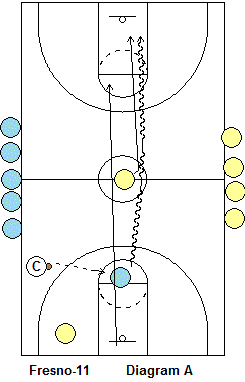
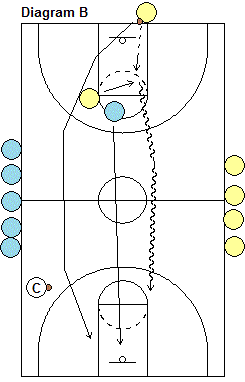
If the offensive player scores, he becomes a solo defender and sprints back to the paint. The defense immediately inbounds the ball (diagram B), and advances it quickly up the court in a 2-on-1 attack on the defender.
Then the next three players come onto the court, with teams alternating offense and defense. For example, with the second group, one yellow would be on offense vs two blue defenders. Keep score with 1 point for each basket and play to a specified number. Losers run (or do push-ups). The player who makes the winning basket must make a free-throw to verify the victory, otherwise both teams run.
Fresno-22 Drill
This drill is similar to "Fresno-11", but is 2-on-2. Divide into two teams, blue and yellow. In diagram A below, we start with two defenders (yellow) and two offensive players (blue). One defender is on the end line and one is at half-court.The two offensive players start just above the arc, and one receives the pass from the coach, and the offense advances the ball quickly up the court and tries to score in a 2-on-1 situation. In this drill, the half-court defender is permitted to drop back to slow down the 2-on-1 break, while his/her teammate sprints the length of the floor in pursuit to help. The endline defender cannot leave until the ball is passed in by the coach.
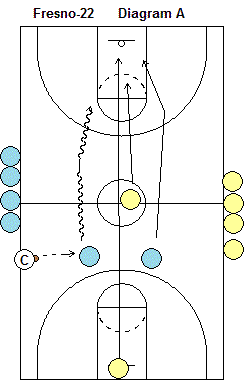
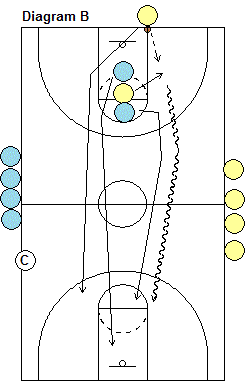
If the offense (blue) scores, they become defenders and try to deny the inbounds pass by stacking up with one defender in front and one behind the offensive player (diagram B), like we do with our "61" press defense. The offense (yellow) immediately inbounds the ball, and advances it quickly up the court and tries to score. The defenders (blue) match up and pressure the ball up the court. These four players are done when there is either a score or a stop.
Then the next four players come onto the court, with teams alternating offense and defense. For example, with the second group, two yellow would be on offense vs two blue defenders. Keep score with 1 point for each basket and play to a specified number. Losers run (or do push-ups). The player who makes the winning basket must make a free-throw to verify the victory, otherwise both teams run.
See the complete article in the members section.
Sign up now!
The complete article also includes:
- Colors 5-on-5 Drill
- "Cardinal" 2 vs 1 Drill
- Full-Court Progression Drill